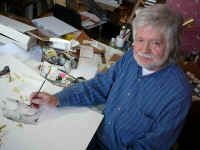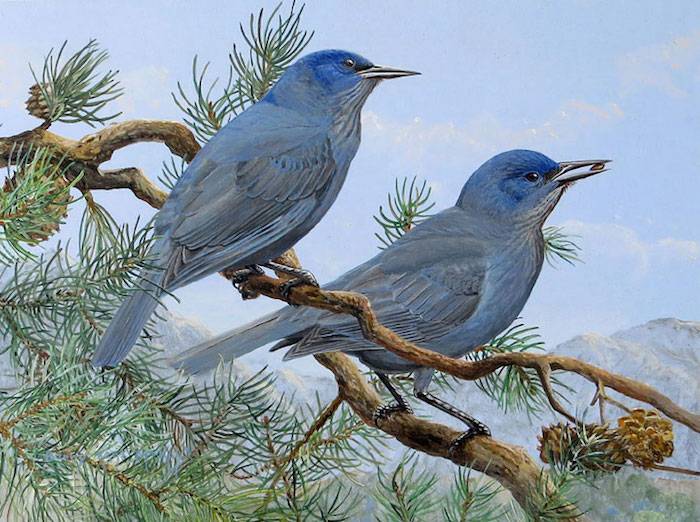
 Art by Barry Kent MacKay
Art by Barry Kent MacKay
An All-Creatures.org
Art and Photo Presentation
In this section are copies of original works of art. All of them are dedicated to helping us live according to unconditional love and compassion, which is the foundation of our peaceful means of bringing true and lasting peace to all of God's creatures, whether they are human beings or other animals.
Pinyon Jay (Gymnorhinus cyanocephalus)

(Artwork - 115)
Pinyon Jay (Gymnorhinus cyanocephalus)
A few years ago my good friend Pete Moulton, who lives in Arizona, was kind enough to find directions to where, during all-too-brief a visit, I might see my first ever Pinyon Jays. I don’t go after birds to add to my life list, but rather because I really want to see them, and sure enough, up near Flagstaff, I was able to intercept a flock of them, amid junipers. And now, a few years later, I have produced this painting of a pair of the birds, which, typical of jays, show virtually no colour or pattern difference between the sexes.
But there is much about them that is not typical, and part of that starts with their unusual range. They are essentially endemic to the lower forty-eight U.S. states, but only those that are west of the prairies and east of the Rockies. Nowhere do they normally reach coastal regions. They are therefore quintessentially birds of the rugged, dry foothills and low mountains, mesas, pine and juniper-studded highlands and rugged rock badlands I so love to visit in the interior western U.S.
They are also one of only two types of jay that have no tufts of feathers over their nostrils. The other is the otherwise an entirely different species called the Crested Jay (Platylophus galericulatus), found in southeast Asia, and Borneo. I have seen and painted it, as well. The only other member of their family, Corvidae, with this feature is the Rook (Corvus frugilegus), which I have seen more than the other two, but have yet to paint. I hope to do so! They are common in Eurasia.
Like many other jays the Pinyon has a brilliant memory and can recall where it has stored huge numbers of seeds and nuts (including the pinyon nuts that they, like I, so enjoy eating) and can retrieve them a long time later. And also jay-like, they are blue, although it is a drab gray-blue, a very soft and pleasing colour, becoming quite bright on the head, especially toward the face. Their straight beaks remind me of another Corvid, the nutcracker, more than other jays, and like nutcrackers they tend to strut and walk about on the ground; other jays tend to take long hops. Their tails are short, again unlike other jays and other Corvids,that usually have medium to long, and often quite long, tails.
They are highly social, seen in flocks even while breeding, with the flocks remaining together through the seasons, and pairs staying attached, within the “home flock” even when not breeding.
The painting is in acrylics on compressed hardboard, is approximately life size and is 12 by 16 inches.
Return to: Art by Barry Kent MacKay - Page 2
Copyright © Barry Kent MacKay
Barry describes himself as a Canadian artist/writer/naturalist.
See his website:
Return to
Art by Barry Kent MacKay
Return to Art By Various Artists
Return to Art and Photo Journals and Galleries









